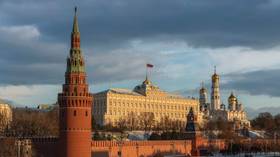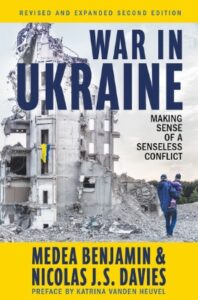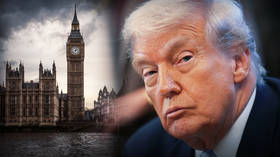
As all cricket and football followers know, the British are bad losers. They blame the other side or the umpire; they stampede inside the stadium, then they riot outside.
They believe their cleverness is in getting the media to portray their defeats on the battlefield as feats of heroism. That’s been the British story against Russia from the charge of the Light Brigade in the Crimean War in 1854 to the Novichok operation of 2018. The success of both these stories as wartime propaganda has depended on public belief in little fools sitting on tall horses — noblemen whose ambition has braced them against their deceit and camouflaged their mental incapacity.
In March 2022 Anthony Hughes was the small nobleman whom His Majesty’s Government (HMG) in Whitehall put in charge of turning a failed MI6 operation into a John Le Carré thriller in which British morality stumps Kremlin evil. Le Carré – whose real name and job were exposed by Kim Philby for the KGB — earned £100 million for his efforts; Hughes has been paid £192,110, plus £5,529 in train fares and overnight bedrooms.
Hughes’s publication, released on December 4, runs to 126 pages, plus 47 pages of references, name lists and other appendixes. In the direct quotes to follow from the Hughes report, the page numbers are given for each reference.

Left: The report is at https://dsiweb-prod.s3.eu-west-2.amazonaws.com/uploads/Web_Accessible_E03283426_Project-Orbit.pdf
Right: Hughes presents his report on December 4, 2025. Click on the Dawn Sturgess Inquiry website for the full proceeding records and the preceding inquest archives.
Hughes reports how his brain has worked in the second of his conclusions at page 123: “if I state a fact, or say that it is ‘likely’, I have found it proved at least on the balance of probabilities, that is, to the ordinary civil standard adopted in UK courts. Where I say that I am ‘sure’, I have been satisfied of that fact to the level generally applied in criminal courts, that is, beyond reasonable doubt. Other expressions, such as that something is ‘possible’, do not represent findings of fact but are indications of my state of mind.”
For forensic analysis of Hughes’s “state of mind”, the bar has been set low enough in this two-part series for the reader to judge whether what the judge adduces to be evidence is all there is; or all that is provably true independent of what Hughes has to say; or no more than the British Government has been confident Hughes would be too loyal or too incompetent to doubt.
That Dawn Sturgess — the only person in the world to have died from a dose of the alleged Russian poison known as Novichok — was clinically dead at her apartment on June 30, 2018, by the time the paramedics arrived is one of Hughes’s certainties. “It is absolutely clear that her condition was in fact unsurvivable from a very early stage – indeed, from before the time the ambulance crew arrived to treat her. This was a result of the very serious brain injury that was itself the consequence of her heart stopping for an extended period of 30 minutes or so immediately after she was poisoned. Looking back, I am sure that no medical treatment could in fact have saved her life” [page 123].
Hughes concludes also that he is “sure that [Alexander] Petrov and [Ruslan] Boshirov brought with them to Salisbury the ‘Nina Ricci’ bottle containing Novichok made in Russia that was subsequently responsible for Dawn Sturgess’ death.” Hughes also claims he is sure that three Russians who were tracked by the UK security agencies had “the intention of working together to kill Sergei Skripal”; that “I am sure that Petrov and Boshirov brought with them to Salisbury the ‘Nina Ricci’ bottle containing Novichok made in Russia that was subsequently responsible for Dawn Sturgess’ death. It was probably this bottle that they used to apply poison to the door handle of Sergei Skripal’s house”.
This slip from certainty to probability doesn’t deter Hughes’s conclusion that “there is a clear causative link between the use and discarding of the Novichok by Petrov and Boshirov, and the death of Dawn Sturgess… I am sure that, in conducting their attack on Sergei Skripal, they were acting on instructions. I have concluded that the operation to assassinate Sergei Skripal must have been authorised at the highest level, by President Putin. I therefore conclude that all those involved in the assassination attempt (not only Petrov, Boshirov and Fedotov, but also those who sent them, and anyone else giving authorisation or knowing assistance in Russia or elsewhere) were morally responsible” [page 124-125].
“Must have been” and “morally responsible” are not the courtroom standards Hughes defined for himself. They represent the standard of beyond unreasonable doubt – British moral certainty of Russian evil leading to the judgement of moral responsibility for that evil.
In between reasonable doubt and unreasonable conviction – between the tested evidence and the propaganda – Hughes reveals his certainty that in 2018 Novichok was a Russian weapon, not a British, American, Iranian, Korean or other state weapon, and that his evidence for this comes from UK officials, intelligence and propaganda agencies. “There is no reason to doubt the information made widely public by Drs Mirzayanov, Uglev and Fyodorov many years before the events which concern this Inquiry. In his letter of 13 April 2018 to the Secretary-General of NATO, Sir Mark Sedwill (then National Security Adviser, HM Government) confirmed that this open-source reporting was not only ‘credible’, but consistent with intelligence which showed that Russia continued to produce and stockpile small quantities of Novichoks in the 2000s.44 This is an issue which I considered specifically in closed session; the closed material adds further support to my conclusions” [page 13].
This is a description of hearsay. Hughes ignores all the public evidence which contradicts it.

For the evidence reconstructing the Skripal attack and the subsequent Sturgess death as an MI6 operation to foil Russian agents on mission to exfiltrate Sergei Skripal and return him to Russia, and the British government’s effort to mobilise public opinion for war against Russia on the Ukraine battlefield, read the only two books available here; and Tim Norman’s three-part series discrediting the Hughes hearings at Part 1, Part 2, and Part 3.
Instead, Hughes reports that “Petrov and Boshirov had the opportunity to apply the Novichok to the door handle between those times. There was a plain opportunity to do so during Trip 3…during the 16 minutes between being on camera at the Shell petrol station and re-appearing on Devizes Road. There might have been another opportunity during Trip 4… but this would have been much more restricted for time. The question of whether Counter Terrorism Policing obtained DNA and fingerprints from No. 47 was explored in the open hearings… At the request of the family of Dawn Sturgess, I enquired in closed hearings whether further detail was available. From that, I am able to conclude that there has been nothing further relating to DNA and fingerprint testing of value to the investigation to date” [page 52].
In sum, there is no evidence of any kind that the alleged assassins put Russian Novichok on the Skripals’ door handle.
The evidence from Yulia Skripal in hospital, in reply to questions from her treating doctor, Stephen Cockroft, was that she believed she had been sprayed with a poison by an assailant at lunch in a restaurant much later. Hughes has dismissed Skripal’s testimony. “A note in Yulia Skripal’s medical records suggests she appeared to assent to the suggestion that she had been sprayed. This is also suggested by the statement of a nurse who entered the room as the question was being asked. However, Dr Cockroft’s evidence was simply that she nodded or shook her head from time to time before the re-sedation took hold, but not that she positively agreed or disagreed with the questions asked” [page 48].
This is false. Cockroft’s evidence was that when he asked his questions, Yulia Skripal blinked her eyes in a signal form of communication which Cockroft suggested after his patient revived from sedation, and before orders were given to put her into a coma again.
Hughes has dismissed this crucial evidence. “The questioning was clearly inappropriate,” he has concluded. “Materially for the Inquiry, the exchange under sedation provides no reliable evidence at all about how Yulia Skripal was exposed to the Novichok. When, in due course, she was able properly to be interviewed, she made it clear that she did not know how she came to be exposed to the Novichok” [page 49]. Hughes was lying – Skripal was not under sedation when she answered the doctor at her bedside. Hughes was fabricating when he claimed the subsequent police and security service interrogations of Skripal were the “proper” interviews.
Hughes acknowledges there is no evidence at all that the Russian assassins came within several hundred metres of the Skripal house in order to attack the Skripals or their door handle. Instead, Hughes has fitted into the gap in evidence of the alleged crime a judicial speculation. “There was clearly [sic] an opportunity [sic] to pass, or visit, or view Sergei Skripal’s house in that intervening 17 minutes” [page 40]; and then, minutes after the alleged murder attempt at the door handle, CCTV records of the Russians and the Skripals lead to the inference by Hughes: “the camera in Devizes Road that Petrov and Boshirov walked past at 13:40 had been passed just five minutes earlier by the Skripals, who were travelling in Sergei’s car and heading into Salisbury city centre for lunch…It follows [sic] that the two men might [sic] have been in a position to see the departure of the Skripals from their home” [page 40].
“Might” is an untested, unverified possibility, but in Hughes’s judgement, it does more than “follow” inferentially — this is known by the technical term in jurisprudence as guesswork. Sic is legal Latin for a Hughes hunch.
In summary, Hughes presents no evidence of the weapon in the possession of the accused murderers, no evidence of the murderers at the crime scene; no evidence that the victims, the Skripals, were directly poisoned through their hands; no evidence of the murderers’ intention to kill Sergei Skripal; and no evidence from the victims’ themselves, neither the Skripals, nor Sturgess, nor her boyfriend. Also, the chain of custody in finding and testing Novichok in a bottle on a kitchen bench, in other locations, and in blood drawn for testing hours, days, and weeks after the alleged crime is so faulty as to allow tampering, fabrication, and falsification which should have made the evidence inadmissible in Hughes’s judgement.
As for the allegations of criminal intention on the part of the accused Russians, Hughes provides nothing. Instead, he has detailed the intelligence service and police evidence of the paperwork preceding their flights to London; then the CCTV and telephone tracking evidence of their movements in London and Salisbury. There is no evidence of what was inside their bags; no evidence that they were carrying Novichok in one or more perfume bottles. “I do not think that it is legitimate to draw any firm conclusion from the transfer of the rucksack” [page 39], Hughes acknowledges from the available CCTV records that he neither knows what was in the bags the Russians were carrying or why.
After they have publicly denied the charges against them, Hughes dismisses the evidence, just as he had of Yulia Skripal’s unforced testimony to her doctor. “It has not been possible for me to investigate the reliability of these statements nor of their authors, and I do not therefore rely on them” [page 25].
Instead, Hughes concludes he is certain that after the assassins had lethally dosed the Skripals’ door handle, at least fifteen minutes later “Sergei Skripal’s hands were contaminated with Novichok at this point” [page 18]; he then used these hands to pass bread to two boys to feed ducks in a park pond. That neither the boys nor the ducks showed any poisoning symptoms, Hughes has concluded: “given the evidence I heard regarding the toxicity of even tiny amounts of Novichok and its transmission through skin contact, as well as other routes…it may well be a matter of luck that the boy who took the bread from Sergei Skripal was not more gravely affected” [page 19]. Conviction based on the possibility of luck is generally known as superstition. As a courtroom standard in England, it ended with the Witchcraft Act of 1735.

No direct testimony from the Skripals appears in the report. Hughes didn’t allow any cross-examination or public testimony by the Skripals on the ground that “it proved unsafe for me to require Sergei or Yulia Skripal to attend the open hearings to give oral evidence” [page 15]. Hughes fails to explain why he himself did not interview the Skripals in closed proceeding at a secret location. If the security of several dozen closed sessions had been tested to the satisfaction of the Government, of the police, and of the judge, why had he failed to test the Skripals directly? There is no answer – and from the British media has come no doubt, scepticism, or suspicion that there is an alternative explanation.

Sources: The Guardian and BBC.
In the very last line of the report it is revealed that Sergei and Yulia Skripal weren’t represented by Adam Chapman at the London law firm of Kingsley Napley – motto, “when it matters most”. However, Chapman had appeared in court many times, confirming to the judge that he was in communication with the Skripals and receiving instructions from them on what to say. Instead of Chapman, a person named Natalie Cohen has now been listed by Hughes as doing that job.
According to her law firm resumé, until 2024 Cohen had spent her career as a state employee litigating for government ministries and official agencies in court cases. In Cohen’s career advertisements and in the Hughes report, Cohen claims no credit for representing the Skripals in the proceedings. If she had, she would have been lying.

Source: The Dawn Sturgess Inquiry, page 174.
Instead, buried in the very small print of a notice issued by Hughes in April 2024, he recorded that Chapman had told him he was retiring and that in his place Chapman was nominating Cohen to represent the Skripals. Note – Chapman nominated Cohen; the Skripals did not; Hughes didn’t care.
“I know how Government and policy making works from the inside will hopefully be a valuable perspective for clients,” Cohen announced in a selfie for Kingsley Napley. Her record reveals cases for the regional police. In the Grok summary, “her expertise focused on defending government decisions against claims of unlawfulness, procedural unfairness, or breaches of human rights under the Human Rights Act 1998.”
There is no evidence that the Skripals knew Cohen or agreed to have such a state lawyer represent them. “Accordingly”, Hughes recorded, “I am satisfied that Sergei Skripal and Yulia Skripal have appointed Natalie Cohen as their qualified lawyer.”
“The lie told often enough becomes the truth” – Vladimir Lenin recognised the method of state propaganda long before Adolph Hitler and then Joseph Goebbels adopted it, claiming they were following the method of Winston Churchill. Lord Hughes of Ombersley is small fry by comparison; his report is nothing new. Lenin’s heirs turn out to have the antidote.
To be continued in Part 2 to follow.
The post
Lord Hughes Buries the Skripals Alive first appeared on
Dissident Voice.
This post was originally published on Dissident Voice.










 (@Simo7809957085)
(@Simo7809957085) 